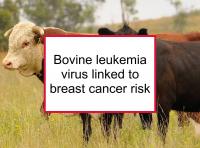Exposure to HPV, Epstein-Barr, human cytomegalovirus (HCMV), measles, mouse mammary tumor virus or the closely-related human mammary tumor virus, and bovine leukemia virus (BLV) all have been proposed as contributing to breast cancer risk, although the findings are controversial.
BLV is a virus closely related to HTLV-1 that infects the majority of U.S. beef and dairy cattle herds — one study estimated that 83% of dairy herds are infected with BLV. The virus does not normally cause obvious illness in cattle and the majority of infected cattle are not culled from their herds. Now a new study has reported that women with BLV in their breast tissue could be three times as likely to have breast cancer as women without BLV.
Latest research finds BLV in breast associated with breast cancer
The case-control study referenced at the beginning of this news story was designed to investigate whether the presence of BLV in human breast tissue is associated with breast cancer. A number of breast cancer risk factors have been well documented, including age, parity and age of first birth, hormone exposures, radiation exposure, genetic mutations, and various aspects of lifestyle. However, the agents that induce cellular changes from normal to malignant are not well understood.
The authors previously detected BLV in human breast epithelial cells (the type of cell in which breast cancer typically develops). To conduct the present study, the authors used archival breast tissue from 239 donors. Medical records and examination of tissues by an anatomical pathologist were used to categorize the tissue as coming from women with breast cancer, having precancerous changes, or normal. Exposure to BLV was determined by in situ-PCR detection of a biomarker, BLV DNA, in the breast tissue.
Breast tissue from women with breast cancer was twice as likely to contain BLV DNA as normal tissue (59% compared to 29%). In addition, in women with precancerous breast changes, the rate of BLV (38%) was inbetween that of normal women and women with invasive breast cancer. The authors calculated that women with BLV in their breast epithelial tissue were three times as likely to have breast cancer as women without BLV. BLV was found more often in estrogen receptor positive (ER+) (68%) than in ER- (50%) samples and more often in progesterone receptor positive (PR+) (74%) than in PR- (51%) samples.
Further analysis showed that the BLV did not appear to be in its usual latent state in 6% of the women, indicating that viral replication could be occurring. The authors conclude that the presence of BLV was significantly associated with breast cancer among the specimens in this study. The level of association is comparable to those of well-established breast cancer risk factors related to reproductive history, hormones, and lifestyle. The association is exceeded only by breast cancer risk factors related to genetics (familial breast cancer), high dose ionizing radiation, and age, according to the authors.
